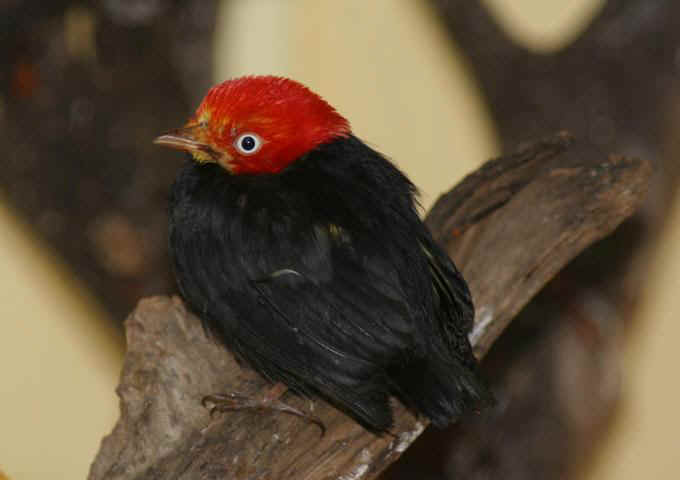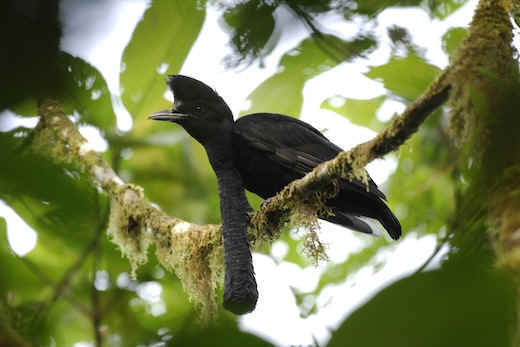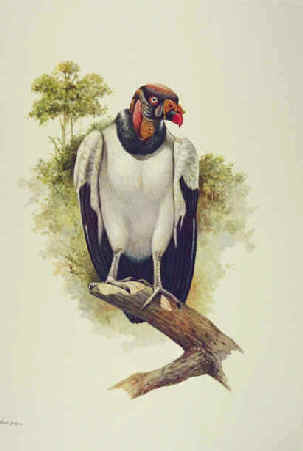
E-mail: font@focusonnature.com
Phone: Toll-free in USA 1-888-721-3555
or 302/529-1876
Website: www.focusonnature.com
 |
PO Box 9021,
Wilmington, DE 19809, USA E-mail: font@focusonnature.com Phone: Toll-free in USA 1-888-721-3555 or 302/529-1876 Website: www.focusonnature.com |
A
Focus On Nature Tour
in
WESTERN and NORTHERN
Ecuador
For Birds mostly, but also
Butterflies
and other Nature
July 23- August 4, 2016
Tour
with Armas Hill,
to be led by expert local Ecuadorian guides
Itinerary
follows below

A Red-capped Manakin
Among the birds during this tour,
many that are regional endemics & specialties.
among groups including hummingbirds,
tanagers, antpittas, other antbirds,
flycatchers, foliage-gleaners,
cotingas,
parakeets and potoos.
And many of these at special places:
in reserves that have been established
to preserve habitat and protect species.
You'll get to know these places:
the Canande Reserve, Playa de Oro,
Mindo and Milpe.
The birds and their status
at each of these reserves are notated
in the 3-part "List & Photo Gallery of Ecuador Birds",
reached from the link below.
Links:
A List & Photo Gallery of
Ecuador Birds, in 4 Parts:
Part #1: Tinamous to Swifts Part
#2: Hummingbirds to Flycatchers
Part#3:
Antshrikes to Grosbeaks
Part #4: Vireos to Grosbeaks
A List & Photo Gallery of South America Mammals
A List & Photo Gallery of South America Butterflies & Moths, in 6 parts
Itinerary:
Sat, Jul 23:
Arrival in Quito, Ecuador. Overnight in
Quito.
Sun, Jul 24:
This day we'll visit a new and exciting site in the western
foothills of the Andes, where
such scarce birds as the Esmeraldas Antbird, Choco Vireo, Indigo
Flowerpierer,
and both Rufous-brown and Black Solitaires have recently been found. There is
also a good opportunity to see the endemic and gorgeous Orange-breasted
Fruiteater, that is surprisingly numerous, along with Glistening-green and
Moss-backed Tanagers, and Pacific Tuftedcheek.
We'll be at the lodge before dark to view the incredible hummingbird feeders,
where as many as 20 different species can be seen, including the Violet-tailed
Sylph, Brown Inca, Purple-bibbed Whitetip, and Purple-throated
Woodstar.
Mon,
Jul 25:
The now-famous antpitta reserve near Mindo will undoubtedly be a highlight of
the tour. Here, a local farmer has started hand-feeding Giant, Moustached, and
Yellow-breasted Antpittas with amazing success.
We also will have a chance to see other Choco bird
specialties, including the
Velvet-purple Coronet and Empress Brilliant.
In the afternoon, we'll bird in the upper Tandayapa Valley to see the colorful
Toucan Barbet, Tanager Finch, and Plate-billed Mountain-Toucan.
Tue, Jul 26:
The Mindo Cloudforest
Foundation (MCF)
Reserve is one of the best birding sites in Ecuador. Over a dozen Choco endemic
birds have been found at Milpe, though the highlight for many visitors is the
lek of Club-winged Manakins. The males use their wings to make buzzing sounds to
impress the females.
Other avian targets are the Choco Trogon and the Ochre-breasted and
Rufous-throated Tanagers.
Afterwards, we go to the Canande Reserve. Some birds along the way can include
the Ecuadorian Ground-Dove, Snowy-throated Kingbird, Swallow Tanager, and
Pacific Hornero.
We'll arrive at the Canande Lodge in the mid-afternoon. Once there, we can see
Red-capped Manakin, Rufous Piha, Slate-throated Gnatcatcher, Scarlet-thighed
Dacnis, and at the end of the day, the Choco Poorwill.
But before going further, let's take a moment for a few words about what is in
the Canande Reserve, and about that word "Choco"
as in the name of the Poorwill.
The "Choco" tropical rainforest, a
mixture of primary and secondary forest, is a biome that extends from the
Pacific coastal lowland of northwestern Ecuador north through Colombia to the
Darien of Panama.
The region is characterized by high rainfall, high species diversity, and a high
proportion of endemic species.
Less than about 25 per cent of the Choco remains intact overall, with about 10
per cent remaining in Ecuador.
Birdlife International has listed 62 bird
species as endemic to the Choco bioregion.
In the Canande Reserve, there are 37 species
of Choco endemics that are threatened.
In addition, the Great Curassow is present - a species not threatened or
endemic to the Choco, but close to extirpation within Ecuador.
Other notable threatened birds in the reserve include: Great Green Macaw,
Baudo Guan, Plumbeous Forest-Falcon, Banded Ground Cuckoo, Long-wattled
Umbrellabird, Scarlet-breasted Dacnis, and Yellow-green Bush-Tanager.
In all, over 300 species of birds have been found in the Canande
Reserve.

Long-wattled Umbrellabird
Four cat species occur at Canande: Jaguar,
Puma, Ocelot, and Margay. Other mammals include Collared Peccary
and Red Brocket Deer.
Three species of monkeys are regularly seen close to the lodge: the Mantled
Howler, Brown-headed Spider Monkey, and White-headed Capuchin.
A survey of the reptiles and amphibians in the reserve found 71 species,
35 of which are Ecuadorian endemics and 3 are globally threatened.
Colorful Dendrobates frogs are conspicuous around the lodge.
Data from the survey has been included in a recent book about the reptiles and
amphibians of the Ecuadorian Choco.
A survey of the butterflies in the reserve has also been published in
another recent book, and a new species of butterfly has been named Eustelasia
jocotoco (after the Jocotoco Foundation that was involved in the creation
and the continuance of the reserve.
Botanical studies have not surprisingly shown that there are many unusual and
threatened plant species in the Canande Reserve.
These include a thriving colony of a critically endangered lily and a
rare palm.
A new species of Liparis orchid has been found at
Canande.
3 nights at the Canande Lodge.
And now back to more about the birding:
Wed, Jul 27:
Some of the best birding at Rio Canande
is by foot up to the "mirador"
. There have been recent sightings of extremely rare Banded Ground-Cuckoos.
Sightings of this enigmatic species have become more regular at Rio Canande.
Local guides have determined that there are at least 3 territories in that
area.
There is also a good chance to see the rare & local Golden-chested Tanager
on its territory.
Some other birds in the area include: Broad-billed Sapayoa, Blue-crowned Manakin,
Black-tipped Cotinga, Great Jacamar, and for those who want a bigger bird, the
Ornate Hawk-Eagle.
Thu, Jul 28:
Less than an hour from the lodge, and past the tiny village of Hoja
Blanca,
we'll be birding along a road where canopy flocks can more easily be seen than
they can inside the forest. A mix of colorful tanagers will be in those flocks.
Other birds that we can see include: King Vulture, Black Hawk-eagle, Barred
Puffbird, Lanceolated Monklet (yes, it's true!), Pacific Flatbill, and
Slaty
Spinetail.

King Vulture
Fri, Jul
29:
After a few hours of morning birding, we'll go to Tundaloma Lodge for one night.
In the afternoon, around the lodge, we may see the rare Brown Wood-Rail and the
Blue Cotinga, in addition to birds more common such as the White-necked Puffbird
and Red-legged Honeycreeper.
Sat, Jul
30:
We'll start the morning birding in secondary forest that can be quite good for
the Five-colored Barbet, both the Black-tipped and the Blue
Cotingas, the
Black-breasted Puffbird, and sometimes even the extremely rare Yellow-eared
Toucanet.
Later we'll drive to the village of Selva Alegre, and take a motorized canoe for
about 2 hours to the Playa de Oro Lodge. The lodge is somewhat basic, but its
location near pristine Choco lowland rainforest makes staying there for 3 nights
very worthwhile!
Playa de Oro is a remote village along the Rio Santiago in the province of
Esmeraldas. The lodge named "Campamento Tigrillo" is
located about 20 minutes upstream from the village. It is as remote as one can
get into the Ecuadorian Choco, and sadly it is one of the last parts of truly
pristine Choco rainforest that remains in Ecuador. The area has many superb
trails. Some are moderately strenuous, but others around the lodge are easy and
flat.
Sun, Jul 31 & Mon, Aug 1:
Most of the best birding at Playa de Oro
is along the forest trails. And that birding can be
rewarding with rare Choco endemics and shy birds such as the Baudo Guan,
Tawny-faced Quail, and Berlepsch's Tinamou. These species are seen here more
easily than anywhere else on earth.
The Streak-chested Antpitta is quite common, and even the rare and beautiful
Rufous-crowned Antpitta can be seen.
This is said to be the best place in Ecuador to see the Broad-billed Sapayoa.
Recent research has shown that bird to be in a monotypic family - one related to
the broadbills of the Old World.
And again there will be tanagers worth seeing such as the Scarlet-and-white
and the Lemon-spectacled.
A flock of birds near the lodge can have within it the forementioned Sapayoa,
but regular members of the flock are apt to include the Western Slaty
Antshrike, White-flanked Antwren, Dot-winged Antwren, Checker-throated
Antwren, Griscom's Antwren, the Tawny-crowned Greenlet, Tawny-faced
Gnatwren, and the Tawny-crested Tanager, as well as the Ducky-faced
Tanager, Stripe-throated Wren, Western Woodhaunter, and the
Sulphur-rumped Myiobious - what's that? It used to be called the Sulphur-rumped
Flycatcher.
Along various trails, we'll have chances to see birds such as the Lita
Woodpecker, Scarlet-browed Tanager, Ochre-breasted Tanager, Ocellated
Antbird, and Black-headed Antthrush, in addition to a couple
"good ones" already mentioned, the Great Jacamar and the Lanceolated
Monklet.
Tue,
Aug 2:
The first morning birding will be around Playa
de Oro and the road to Lita in an
effort to either see something better or something missed until now.
Then, we go higher to a new site, the road to Chical,
a recently discovered birding road that provides a good chance to see a species
very rare in Ecuador, the gorgeous Fulvous-dotted Treerunner, which
actually can be rather common along this road.
Also the Purplish-mantled Tanager, Hoary Puffleg, and again an
opportunity for the Black Solitaire.
We'll spend a night at the Hacienda Primavera, a nice new hotel about 30 minutes
from our main birding area.
Wed, Aug 3:
Early One more time, we'll go a few kilometers from the hacienda for birding in
the prime area of the rare Fulvous-dotted Treerunner, before starting our
travel back to Quito.
There will be plenty to see along the way (the birding, and the new birds during
the tour will not end until our plane lifts from the ground the next day).
A hummingbird in the scrub of the dry region through which we'll pass is
the Blue-headed Sapphire.
During a stop at the Laguna San Pablo, we'll
look for the Ecuadorian Rail and a small flycatcher known as the Subtropical
Doradito. Our last overnight in
Quito.
Thu, Aug 4:
We depart Ecuador this day for home.
Price, in US dollars,
based on double occupancy:
| $2,995 Single supplement: $345 |
Price includes:
All overnight accommodations
in comfortable hotels/lodges
Meals, except those on July 23 & August 4
Land transportation
Entrance fees
Expert bilingual birding guide in addition to FONT leader
Price does not include:
Airport departure tax (if required)
Meals on July 23 & August 4
Items of a personal nature, such as extra drinks, alcoholic beverages, snacks,
laundry, phone calls
A deposit of
$500 will assure a
place on the tour.
![]()